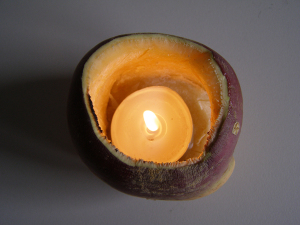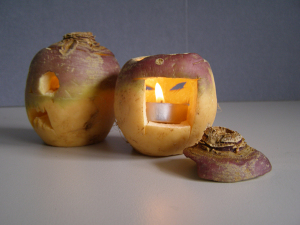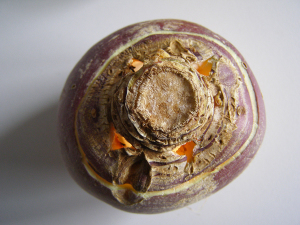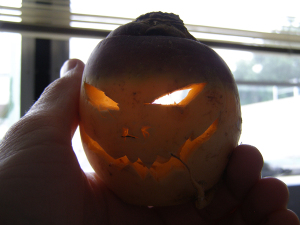Traditionally, Jack-o’-lanterns were carved from turnips, not pumpkins. Pumpkins are a new world vegetable, so of course prior to colonisation of the Americas there were no pumpkins in Europe. Something else was needed for one’s vegetable-based horror skull lamp needs.
I’ve always wondered how easy a turnip Jack-o’-lantern would be to carve, so last night I had a go at a couple. I’m not an especially skilled Jack-o’-lantern carver, so the results are not spectacular, but it works pretty well.
The steps are straightforward, and not very different to carving a pumpkin. I did the following:
- Cut the top off with a vegetable knife leaving enough cap to make a lid.
- Cut the bottom off if needed to make a stable base.
- Cut a circle inside the top of the turnip. Make cross-hatches in the flesh you want to remove using the knife. Start digging out the interior with a teaspoon. You could skip step 3 and go straight to it with a teaspoon if you don’t think you need a cut circle to guide your teaspoon digging.
- Once the inside is suitably hollowed-out, use a vege knife to very gently cut a face.
Some pointers:
- There’s no difference in the pith and innards of a turnip the way there is with a pumpkin. You have to be careful you don’t punch right through the wall of the turnip while digging out flesh.
- The inside of a turnip is about the same consistency as a very hard-frozen sorbet or iceblock.
- You may need to cut an air-hole in the back of the turnip and some breathing holes in the lid to allow air to circulate. The first time I put the lid on turnips with lit candles, the candles snuffed out from lack of oxygen.
- Alternatively, made the mouth big and move it up the turnip, so that it is above the flame, and allows the flame to breath.
- There isn’t a lot of room inside your average turnip. Pick as big a turnip as you can, and don’t burn turnip Jack-o’-lanterns indoors unless you like the smell of slightly burnt turnip flesh.
I found the whole process to be pretty easy. I reckon that it’d be possible to give a turnip with the top lopped off and a teaspoon to an older child as a mini Jack-o’-lantern project while a supervising adult is carving a pumpkin. Obviously, don’t give knives to children, and even though they might only be working with a teaspoon there is still a (probably remote) chance of injury through over-zealous spoon use. Use common sense and supervise accordingly.
Some advantages:
- Carving turnips is probably safe for kids (use your judgement), as it can be done more or less with a teaspoon
- The white colour gives a nice skull-like look.
- The flame is less protected than in a pumpkin, so it flickers a lot more. Left out at night, turnip Jack-o’-lanterns appear and disappear as the flame flickers. It feels much like how an actual Will-o’-the-wisp should look
- I didn’t experiment, but the turnip should be carve-up-able from the outside too. I expect with some practise you could actually carve something that looks a lot like a skull or withered fairy face.
- The scooped out turnip innards could easily be used to make a turnip and potato mash, or similar. No need to waste vegetables.
Disadvantages:
- Tendency to raise a slight stink of burnt turnip when lit.
- Candle is prone to go out in a wind at night.







Alas, poor turnip Yorick! Hehe
Pingback: What is a “turnip-ghost”?A post for Hallowe'en | Jack of Kent blog - News4Security